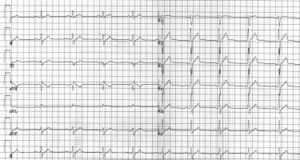Should I be Worried?: Difference between revisions
Jump to navigation
Jump to search
mNo edit summary |
m (moved Should I be worried? to Should I be Worried?) |
||
| (One intermediate revision by the same user not shown) | |||
| Line 19: | Line 19: | ||
[[Puzzle_2006_1_33 - Answer|Answer]] | [[Puzzle_2006_1_33 - Answer|Answer]] | ||
Latest revision as of 20:03, 25 January 2010
| Author(s) | A.A.M. Wilde, H.L. Tan | |
| NHJ edition: | 2006:01,033 | |
| These Rhythm Puzzles have been published in the Netherlands Heart Journal and are reproduced here under the prevailing creative commons license with permission from the publisher, Bohn Stafleu Van Loghum. | ||
| The ECG can be enlarged twice by clicking on the image and it's first enlargement | ||
A 34-year old man comes to your office. He has read in a newspaper about the familial occurrence of sudden death. He suffered a collapse during an episode of viral meningitis accompanied by high fever a few months earlier. A few years ago his elder brother, who was previously found to have idiopathic atrial fibrillation, died suddenly at the age 32 years. Physical examination reveals no abnormalities, including normal heart sounds. Echocardiographic evaluation reveals no abnormalities either. His baseline ECG is shown in figure 1.
What is your interpretation and what would be or should be your next step(s)?
